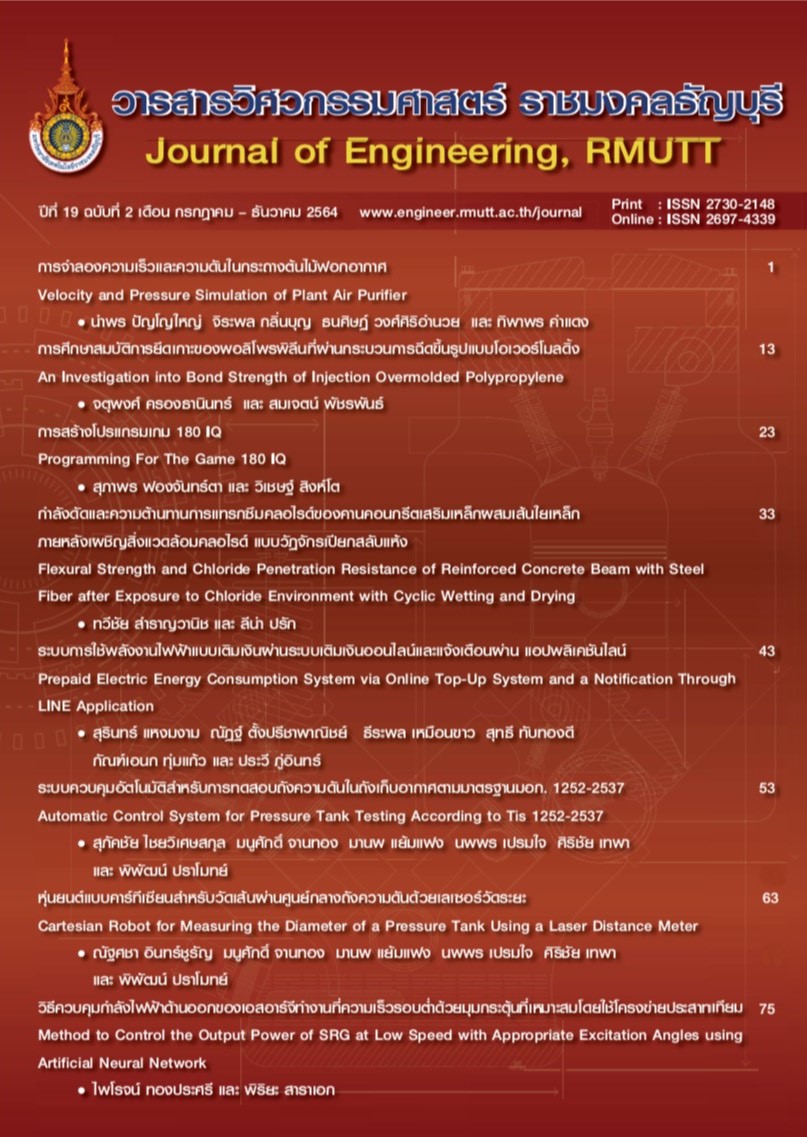การจำลองความเร็วและความดันในกระถางต้นไม้ฟอกอากาศ
Main Article Content
บทคัดย่อ
งานวิจัยนี้มีวัตถุประสงค์เพื่อศึกษาการจำลองความเร็วและความดันอากาศในกระถางต้นไม้ฟอกอากาศที่มีสมบัติของวัสดุปลูกแตกต่างกัน ซึ่งสมบัติของวัสดุปลูกที่ทำหน้าที่กรองอากาศมี 3 ชนิด ได้แก่ ชนิดที่ 1 ความพรุน 0.35 ขนาดรูพรุน 5 µm ชนิดที่ 2 ความพรุน 0.35 ขนาดรูพรุน 2.5 µm และชนิดที่ 3 ความพรุน 0.7 ขนาดรูพรุน 2.5 µm และพัดลมที่ใช้ดูดอากาศแตกต่างกัน 3 ขนาด ได้แก่ ขนาด 4 นิ้ว อัตราการไหลที่ 37.5 50 และ75 CFM ขนาด 6 นิ้ว อัตราการไหลที่ 85 113.33 และ 170 CFM และขนาด 8 นิ้ว อัตราการไหลที่ 170.5 227.33 และ 341 CFM ตามลำดับ จากการเปรียบเทียบผลการกระจายตัวของความดันต่างและความเร็วที่ได้จากการจำลองโดยใช้โปรแกรมคอมพิวเตอร์ พบว่า ค่าความดันต่างและความเร็วแปรผันตามขนาดพัดลม โดยพัดลมขนาด 8 นิ้ว ค่าความดันต่างสูงสุดคือ 96,885.293 Pa และความเร็วสูงสุดที่ตำแหน่งช่องติดตั้งพัดลมดูดอากาศ คือ 6.228 m/s ความเร็วสูงสุดที่ตำแหน่งช่องลมออกจากกระถางส่วนในที่ใส่วัสดุปลูก คือ 9.829 m/s และการเปรียบเทียบผลของสมบัติวัสดุต่อความดันลดและความเร็ว ที่อัตราการไหลเท่ากัน พบว่า วัสดุปลูกที่มีความดันลดและใช้ความเร็วพัดลมสูงที่สุดคือ ชนิดที่ 2 รองลงมาคือ ชนิดที่ 3 และ ชนิดที่ 1 ตามลำดับ และความเร็วขาออกจากวัสดุปลูกสูงที่สุดคือ ชนิดที่ 1 รองลงมาคือ ชนิดที่ 3 และ ชนิดที่ 2 ตามลำดับ ดังนั้นหากใช้เพื่อกรองฝุ่นขนาดเล็กในอากาศขนาด 2.5 ไมครอน วัสดุปลูกที่เหมาะสมที่สุดคือ ชนิดที่ 3
Article Details
บทความ ข้อมูล เนื้อหา รูปภาพ ฯลฯ ที่ได้รับการตีพิมพ์ในวารสารแนวหน้าวิจัยนวัตกรรมทางวิศวกรรม ถือเป็นลิขสิทธิ์ของวารสารฯ เท่านั้น ไม่อนุญาติให้บุคคลหรือหน่วยงานใดคัดลอกเนื้อหาทั้งหมดหรือส่วนหนึ่งส่วนใดไปเผยแพร่เพื่อกระทำการใด ๆ ที่ไม่ถูกต้องตามหลักจริยธรรม
เอกสารอ้างอิง
Zhu Z, Jin H. The analysis and design of small air purifier. IOP Conf Ser: Mater Sci Eng 2019;562(1)012046:1-4.
Plasencia AC. Design of a nature-based air urifier [master’s thesis]. Delft, Netherland: Delft University of Technology;2020.
Feng Z, Long Z, Chen Q. Assessment of various CFD models for predicting airflow and pressure drop through pleated filter system. Building and Environment. 2014;75:132-41.
Nassif N. The impact of air filter pressure drop on the performance of typical air-conditioning systems. Building Simulation. 2012;5:345–50.
Intagun W, Khamdaeng T, Prom-Ngarm P, Panyoyai N. Effect of core puncture diameter on bio-char kiln efficiency. International Journal of Biotechnology and Bioengineering. 2018;12(11):435-9.
Panyoyai N, Petchaihan L, Wongsiriamnuay T, Hiransatitporn B, Khamdaeng T. Simulation of temperature distribution in biochar kiln with different feedstock types. Mahasarakham International Journal of Engineering Technology. 2019;5(2):59-64.
Tawonwan T. A study of two-dimensional modeling of behavior of air flow through the cylinder by computational fluid dynamics technique (CFD). Phranakhon Rajabhat Research Journal (Science and Technology). 2017;12(1):38-50. (in Thai)
Gómez-Martín A, Orihuela MP, Becerra JA, Martínez-Fernández J, Ramírez-Rico J. Permeability andmechanical integrity of porous biomorphic SiC ceramics for application as hot-gas filters. Materials and Design. 2016;107:450-60.
Raffray AR, Pulsifer J, Tillack MS. Modeling flow and heat transfer through porous media for high heat flux applications. La Jolla, CA: the University of California Energy Institute's (UCEI), 2000.
Soloveva OV, Solovev SA, Khusainov RR, Shubina AS, Antipin AV. Numerical simulation of gas flow in porous structures of various geometries. J Phys: Conf Ser 2019;1210 012134:1-7.
Sbrizzai F, Faraldi P, Soldati A. Appraisal of three dimensional numerical simulation for sub-micron particle deposition in a micro-porous ceramic filter. Chemical Engineering Science. 2005;60:6551-63.
ISO 16890-1:2016(en), Air filters for general ventilation–Part 1: Technical specifications, requirements and classification system based upon particulate matter efficiency (ePM).
Velzeboer I, Blom MJ, Duyzer JH. Effects of plant systems on air quality. Petten, Netherlands: TNO, 2019.
Techaampai P. Computational fluid dynamics by finite element and finite volume methods. 2 ed. Bangkok: Chula Press; 2013.
Asawa GL. Irrigation and water resources engineering. New Dehli: New Age International (P) Ltd.; 2008.
Gunashekar S, Pillai KM, Church BC, Abu-Zahra NH. Liquid flow in polyurethane foams for filtration applications: a study on their characterization and permeability estimation. Journal of Porous Materials. 2015;22:749-59.
Eiland R, Fernandes J, Gebrehiwot B, Vallejo M, Agonafer D, Mulay V, editors. Air filter effects on data center supply fan power. 13th IEEE ITHERM Conference; 2012; San Diago, USA.
Mancin S, Zilio C, Cavallini A, Rossetto L. Pressure drop during air flow in aluminum foams. International Journal of Heat and Mass Transfer. 2010;53:3121–30.
Zhang W, Deng S, Wang Y, Lin Z. Modeling the surface filtration pressure drop
of PTFE HEPA filter media for low load applications. Building and Environment. 2020;177(11)106905:1-9.


